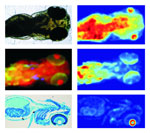X-rays Focusing on Mercury
Organomercury is a well-known poison, and the potential for exposure worries many communities worldwide. Developing embryos are especially susceptible to mercury poisoning, which can result in serious birth defects. Despite the awareness of mercury's adverse health affects, little is known about the mechanisms for mercury toxicity.
A research group led by Graham N. George and Ingrid J. Pickering from the University of Saskatchewan, Canada, used SSRL's beam lines 9-3 and 2-3 to develop a novel approach to identify which cells types attract mercury. They scanned mercury-exposed zebrafish larvae using synchrotron X-ray fluorescence imaging, which gave a direct image of where in the fish the mercury was collecting.
Zebrafish are often used as a model for human development. Cell types that absorb mercury in zebrafish larvae may also collect mercury in human embryos, and knowing which cells absorb mercury is critical to finding the mechanisms of its toxicity. In this study, zebrafish larvae were exposed to varying concentrations of methyl-mercury compounds. The images clearly showed hot-spot areas of high mercury concentrations in the bodies and tissues of the larval zebrafish. The researchers were surprised to discover that mercury strongly collected in the outer layer of the eye lens of the zebrafish larvae, even more than in known target organs such as the brain and liver. This layer is composed of rapidly dividing epithelial cells, since the larvae emerge before their eyes are fully developed. The mechanism for absorption of mercury by these fish eye lens cells may be similar to the mechanism by which rapidly dividing human fetus cells absorb mercury. If mercury similarly concentrates in the eyes of humans, this may help explain how mercury exposure can cause blindness, in addition to damaging the nervous system.
The method that the researchers used also simultaneously locates other elements, including calcium and zinc, in the zebrafish larvae. The technique can also be applied to locating other biologically toxic and important heavy metals such as arsenic and lead, to tracking minerals like zinc, iron and calcium during development, and in understanding the effectiveness of drugs which are supposed to remove toxic metals, such as chelating agents.
To learn more about this research see the full Scientific Highlight
Korbas M, Blechinger SR, Krone PH, Pickering IJ, George GN (2008) Localizing organomercury uptake and accumulation in zebrafish larvae at the tissue and cellular level. Proc Natl Acad Sci USA 105:12108-12112.


